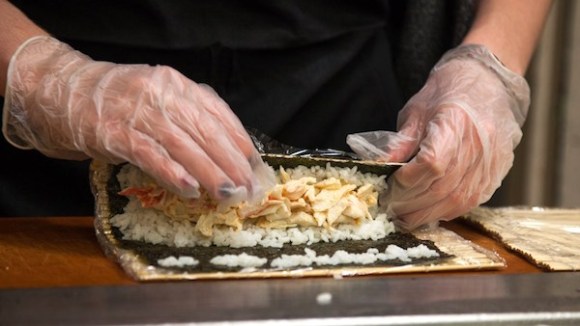
Food fight! Are these foods cultural adaptations, or abominations? Students take up issue with their university’s menu.
If your memories of school cafeteria food are anything like mine, you’d recall such delicacies as stiff rectangles of tough pizza covered in pools of grease, hamburgers with dried-out buns or pale, questionable-looking patties, and frozen vegetables that had been reheated for so long they were basically mush. But it was sustenance, and contained enough salt to make it palatable so those who were hungry, so we ate it.
In university the quality improved a bit, going from cafeteria-style to restaurant-style, but it was still nothing high-class. Definitely no place I’d head to when looking for some authentic foreign cuisine.
But should schools be more careful about what they market as foreign food? Is it disrespectful to serve California rolls and call it “sushi”, or General Tso’s chicken and call it “Chinese food”?
Some international students at Oberlin University in Ohio are raising that point after the school cafeteria served bastardized versions of the Vietnamese banh mi sandwich and Japanese sushi in an attempt to expand and diversify their menu. Instead of grilled pork, pickled vegetables, and herbs on a baguette, first year student Diep Nguyen expressed disappointment when her longed-for comfort food showed up in the cafeteria as pulled pork and coleslaw on ciabatta bread. University junior Tomoyo Joshi was equally unimpressed by the under-cooked rice and cooked fish that appeared as sushi at the school’s sushi bar.
▼ The traditional versions of banh mi and sushi
Images: Wikipedia (GeeJo, Nesnad)
“When you’re cooking a country’s dish for other people, including ones who have never tried the original dish before, you’re also representing the meaning of the dish as well as its culture,” Joshi told The Oberlin Review. “So if people not from that heritage take food, modify it and serve it as ‘authentic,’ it is appropriative.” She also added that “in Japan, sushi is regarded so highly that people sometimes take years of apprenticeship before learning how to appropriately serve it,” and that the school’s version is culturally disrespectful.
Another Japanese student, Mai Miyagaki, suggests a collaboration between cultural student groups and the university’s food service company could help address the issue of serving misrepresentations of other cultures’ food.
The response to Oberlin University’s article has been overwhelmingly against the complaints of the students:
“Are Italian students upset over what passes as pizza, and how do the Mexican students feel now that you can get fish tacos, tofu tacos, and even dessert tacos? Inquiring minds want to know.”
“Is this the Onion??”
“Don’t feel bad. The mystery meat that is legend among American students bears little resemblance to our cuisine, either.”
“I once ordered a burrito in Japan and was excited to see what would arrive. Take my advice: when in Japan do not order a burrito.”
“In Japan, they put corn on pizza. Italian students aren’t whining about it… Nothing from a cafeteria is ‘authentic’ anything. It’s three dollars. Get over yourselves.”
“All cafeteria food is shitty. Welcome to college.”
But how do Japanese netizens feel about the news that their country’s national cuisine has been poorly misrepresented?
“Well in Japan we go around altering curry and ramen and pizza don’t we? This person’s an idiot.”
“If it tastes good what does it matter?”
“It’s fine if they improve it, but this looks gross.”
“I can understand getting upset if they had said ‘This is real sushi, imported directly from Japan!’ but if they didn’t present it like that then who cares.”
The majority also can’t seem to understand the complaints. As the last comment noted, it would be understandable if the school had falsely marketed it would begin selling “authentic” cuisine, but there is no mention that they had.
As mentioned in another comment above, Japan also frequently alters other countries’ staples. But Japan isn’t the only perpetrator in this “butchering” of other cultures’ foods. It happens any time food crosses borders as it undergoes transformations to suit local tastes and available ingredients.
▼ I can almost guarantee you won’t find this “pasta” dish outside of Japan.
Image: Dr.Wallet Navi
Oberlin’s director of Business Operations and Dining Services does plan to hold a meeting soon to resolve the issues. I completely understand the disappointment that comes with expecting some comfort food but not getting what you hoped for (why, Taco Bell Japan??), so if the school is able to deliver to the students’ wishes that will be great, but was the outcry really necessary? Please share your thoughts.
Source: The Oberlin Review, Yurukuyaru
Top image: The Oberlin Review